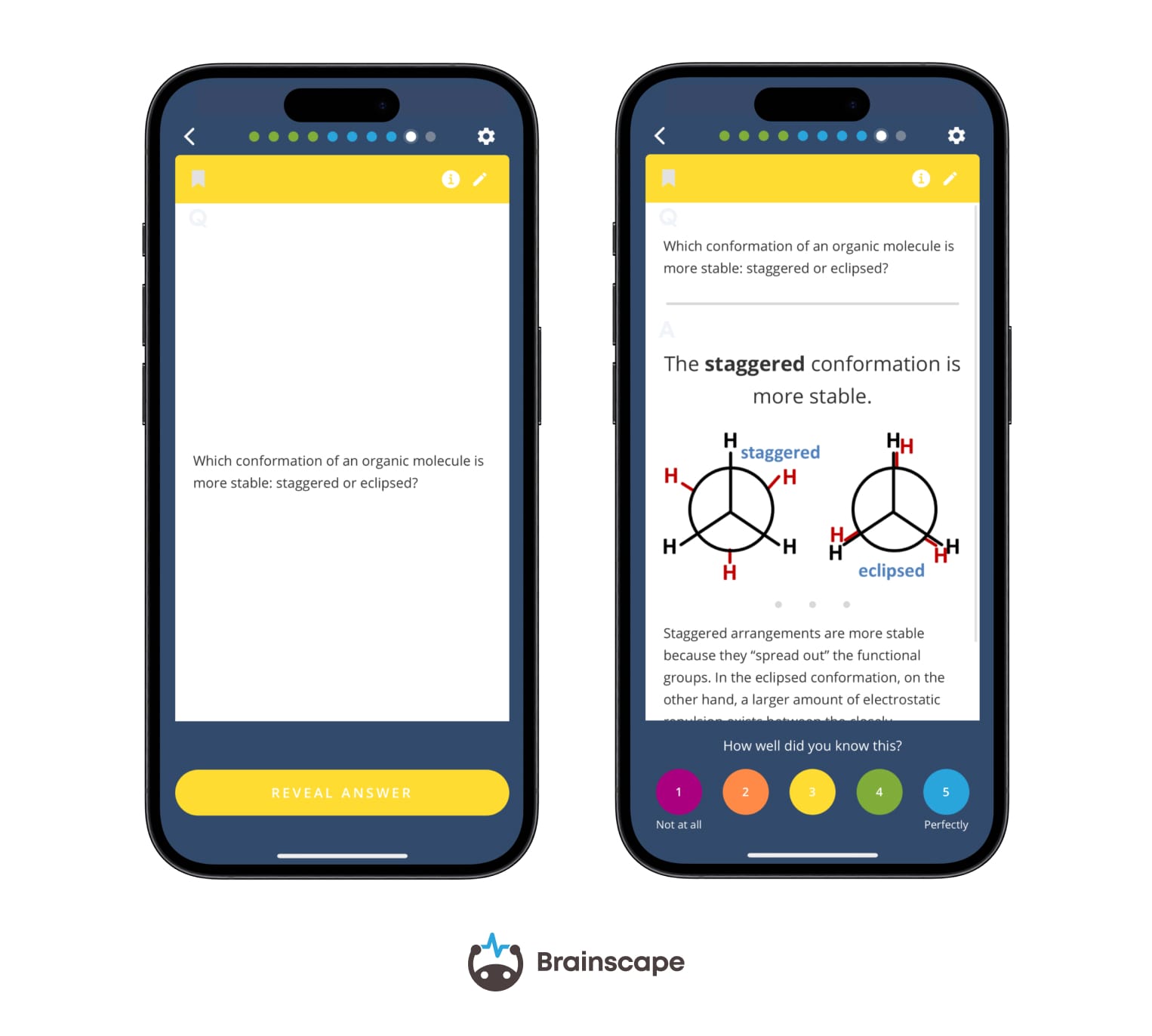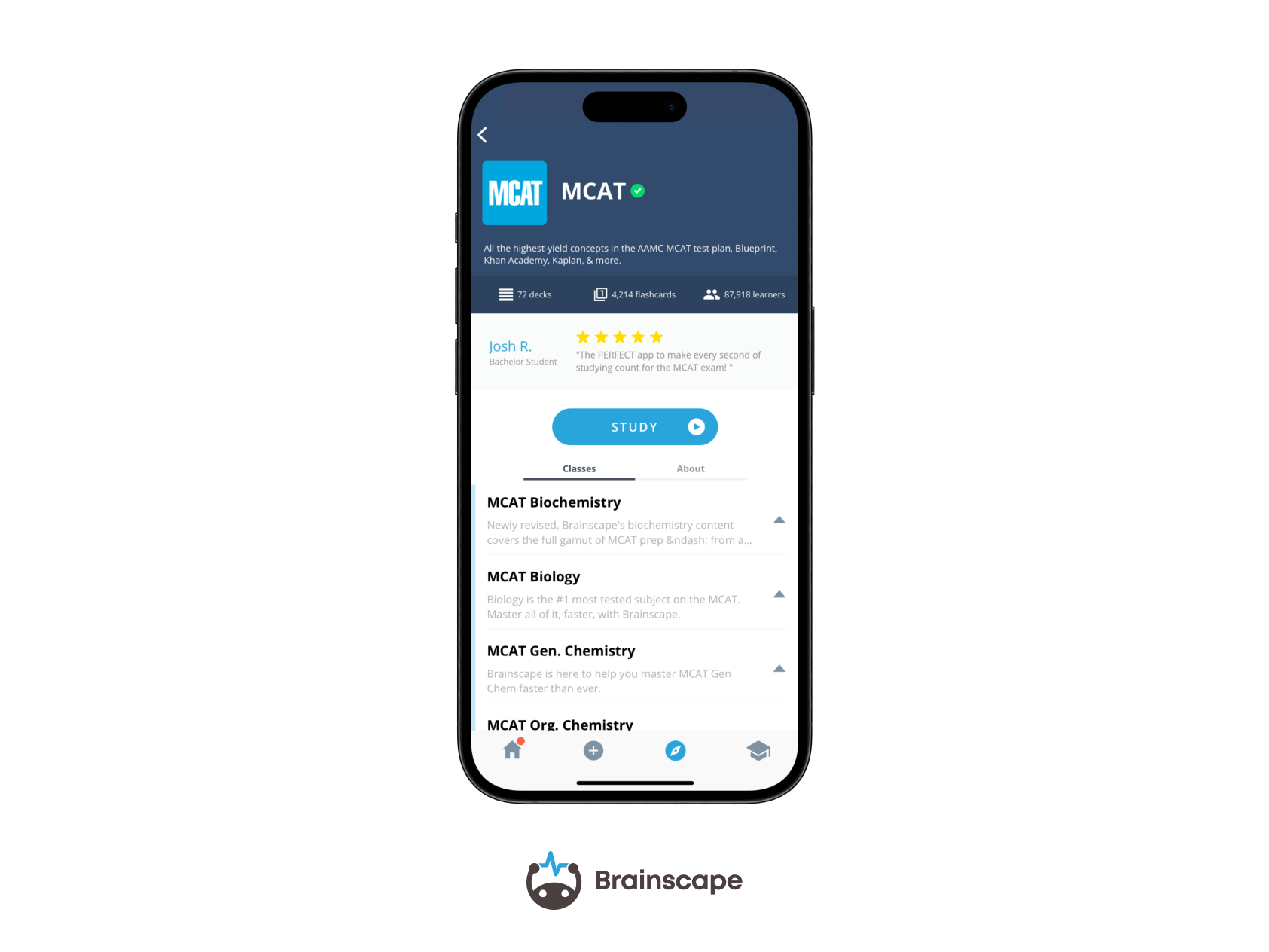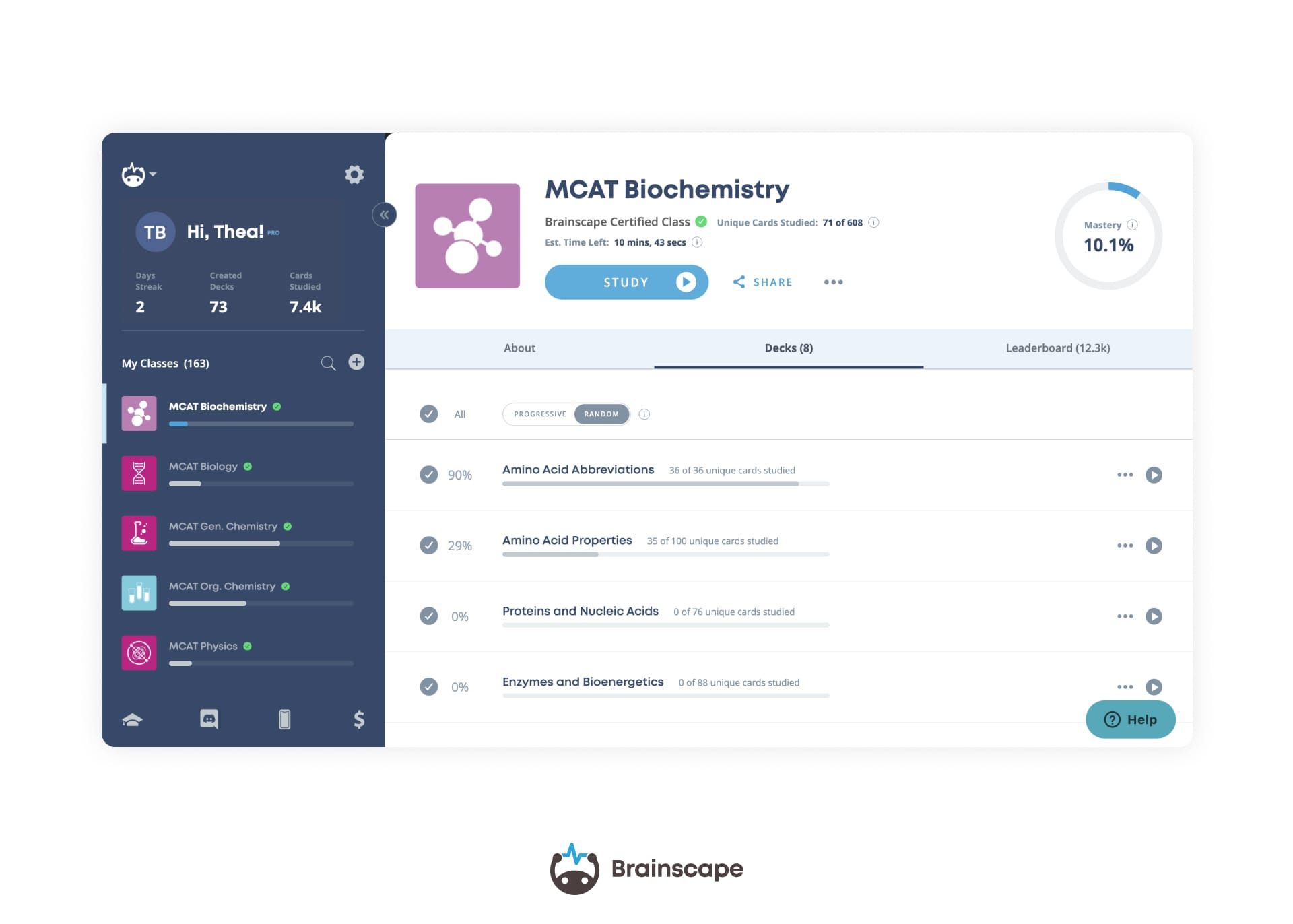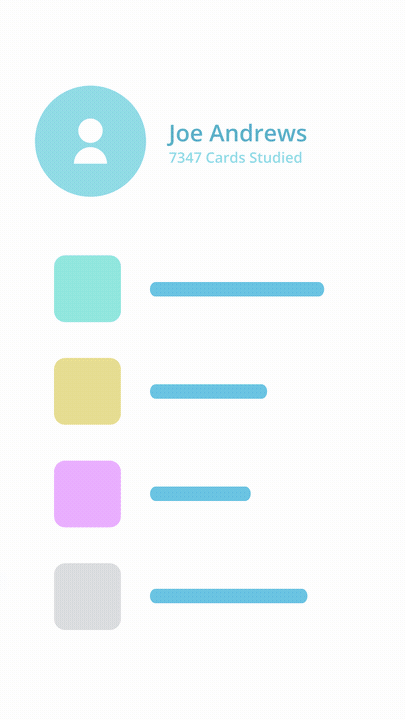As someone who has chosen the pathway to medicine, you’ve set yourself an equally challenging and exhilarating journey. Before you lies a vast landscape riddled with mountains of information, treacherous swamplands of critical, analytical thinking, and valleys of caffeinated, late-night study.
One of the first obstacles through which you must pass is the Medical College Admissions Test or MCAT. Your work is cut out for you, but you’ve got what it takes, especially if you learn some key strategies on how to study for the MCAT more efficiently. Making every second of studying count is exactly what this guide is all about.
The MCAT is a monster of an exam with an equal bearing on content knowledge and analytical, critical thinking skills. And in this guide, you’ll find the tools, advice, and mental strategies you need to prepare for both sides of the MCAT challenge!
Hi, We’re Brainscape!
We’re the brains, minds, and hearts behind the world’s smartest study app. You’ll be learning more about Brainscape during the course of this guide but for now, know that we’ve brought together some of the smartest people in the realm of the MCAT study to compile a comprehensive collection of study guides and digital flashcards for the MCAT.

These 4,200+ smart, digital flashcards cover the most important concepts in the AAMC MCAT curriculum, as well as those taught by Blueprint, Khan Academy, Gold Standard, Princeton Review, Exam Krackers, and other MCAT prep providers. So, no matter which one you're using, we've got you covered!

Our flashcards were authored by our panel of MCAT experts, led by Clara Gillan, a 100th percentile MCAT-taker with a score of 526 and Director of Product at MedSchoolCoach. (So she really knows her sh*t!).
In this guide, Clara will be walking us through the following steps on how to study for the MCAT:
- Understand what is tested on the MCAT exam...
- But even more importantly, understand how that material is tested
- Take a full-length MCAT practice test early
- Gather your MCAT study resources and strategies
- Use MCAT flashcards to help you study
- Create your MCAT study plan
- Include plenty of MCAT practice questions early on
- Create daily study goals
- Learn to prioritize
- Try to keep MCAT study days to 6 to 8 hours (max)
- Take days off, too!
- Mentally prepare to retake the MCAT
With the housekeeping out of the way, let’s jump right in!
Step 1: Understand What Is Tested On The MCAT Exam ...

The first thing you need to know is exactly what topics, concepts, skills, and disciplines are tested on the MCAT exam. The sooner you learn this, the better!
Even if the MCAT is still far in your future, understanding what aspects of your premed classes are and aren’t tested helps you understand the topics you’ll need to recall and the topics (like plants, taxonomy, and some complex organic chemistry) you can forget as soon as class is out.
The Association of American Medical Colleges (AAMC) has a ton of super helpful literature on the anatomy of the MCAT, and we urge you to read those (if you haven’t already) in preparation for the exam. Many students don’t even know that this material exists, so checking it out is an easy way to get a competitive advantage!
Step 2: But Even More Importantly, Understand How That Material Is Tested
Knowing which subjects and topics are tested on the MCAT is important, sure. But this understanding can only get you so far! What you really need to understand is how the MCAT tests content, and it’s likely different than any test you’ve ever taken.
Let’s compare the MCAT to your most recent educational experience: college premed classes. Those classes might have been memorization-dense (biochemistry, anyone?) or included ugly, multi-step math problems that required a calculator.
But your premed classes likely didn’t include a critical reading component, which kept things simple: if you knew the material, you’d get questions right, and if you were shaky on your foundations, you’d be in trouble.
This just isn’t the case with the MCAT.
Contrary to popular belief, the MCAT isn’t ONLY about memorizing the facts. It’s important for you to have the baseline knowledge to inform your decision-making, but the MCAT leans heavily on your critical thinking and passage analysis skills, too.
The bottom line is that only learning content and not exercising those skills of critical thinking is not enough. Just ask any of the 4.0-GPA students who bombed the exam their first time around (and yes, there are many).
According to the AAMC, only 35% of questions on each science section fall into the category of “knowledge of scientific concepts and principles,” while a whopping 65% involve some level of reasoning and problem solving, data interpretation, or experiment-related critical thinking.
It’s, therefore, possible to know your MCAT science content down cold and still perform poorly if you aren’t well-versed in reading dense and unfamiliar content, interpreting graphs, and other MCAT critical thinking skills.
Does this mean science content isn’t important? Far from it! If you don’t have an airtight content foundation, not only will you miss some of that foundational 35% of questions, but you’ll also have much more trouble discerning those content-only questions from questions that require passage information or graphical data.
The takeaway is simple: content is crucial, but it’s only a part of the picture.
Overall, understanding how to study for the MCAT comes down to knowing the nature of the beast you plan to do battle with. If you’re familiar with the exam’s delivery, challenges, tactics, and idiosyncrasies, you can prepare by developing your own strategies for taking it on. And, of course, being prepared eliminates any nasty surprises, while also helping you feel more confident.
This is where MCAT practice questions and tests become essential to your preparation ...
Step 3: Take A Full-Length MCAT Practice Test Early

Rather than simply plowing through all the content from scratch, which is a terribly inefficient approach, take a full-length MCAT practice exam early on to:
- Get a sense of what the exam is like, and
- Get a head start on identifying your strengths and weaknesses.
The AAMC provides a free MCAT practice test (the unscored Sample Test), which we highly recommend taking as early as possible. If you’re concerned about “wasting” a practice test, don’t fret: the AAMC has four scored exams that you certainly can save for later when you feel you’ve prepared adequately. But the best place for the Sample Test (or other MCAT practice exams) is near the beginning of your prep timeline.
After all, it’s crucial to understand what a full-length MCAT exam is like, even before you dive into content review. If you don’t have a sense of the balance between passage-based and discrete (free-standing) questions, or even an idea of what a typical MCAT passage is like, you’ll risk going off-track.
Think of it like studying for a driver’s test without having any idea whether your instructor will ask you to make a few simple left turns or compete in the Indy 500. Your driving practice in that case would start to look a little … weird.
A subsidiary benefit of completing MCAT practice questions early is that the examiners will provide you with detailed feedback on how you did. Based on the answers you got right and wrong, and what topics, concepts, and skills you did and didn’t feel comfortable with, you can start to get a picture of what you need to devote more time to.
(Just remember that even though an MCAT practice exam can take seven hours to get through, it can only test a small fraction of the full scope of MCAT content. So, how you feel while taking each section can begin to give you an idea of your most persistent strengths and weaknesses, but not a comprehensive picture by any means.)
To get this kind of value out of your MCAT practice questions, you should spend several hours working through your results, making notes and flashcards for the concepts you struggled with. Yes, it can be tempting to avoid this work; after all, you probably missed a lot of questions simply because you hadn’t yet covered the material. But a review of practice exams is crucial, and developing good review habits is better done now than later.
Careful review might also uncover some surprises; for example, maybe you were able to use reasoning to get to the correct answer more often than expected, even for questions about topics you’ve entirely forgotten. And of course, this important work will inform the next steps of your preparations: developing a battle strategy—an MCAT study plan—for taking on the real thing!
(We also seriously recommend you take the MCAT practice test as though it’s the real exam—in one sitting, under authentic testing conditions—so you know exactly what to expect and how to prepare.)
Where can I find free MCAT practice questions?
The AAMC offers a suite of MCAT practice tests, one of which is free (providing feedback on the number and percentage of correct answers in each section) and the others for a low cost. These provide a scaled score.
You can also turn to Blueprint Prep MCAT, Kaplan MCAT Prep, and the Princeton Review MCAT Prep for free practice questions and full-length tests.
Step 4: Gather Your MCAT Study Resources And Strategies

Your brain is hardwired to learn information through repetition. But also, the more varied the delivery of that information, the more neural pathways your brain will form to that information, which then helps it become a permanent part of your knowledge bank.
This is the efficiency you want to unlock when planning how to study for the MCAT test: generating a mass of neural pathways to all the information you need to remember to ace the exam.
The best way to do that is through a variety of study strategies and resources that’ll (1) expose you to the information in a variety of ways, rather than just your traditional approach; and (2) keep your brain engaged because you’re “mixing it up” with new and interesting media or modes of content delivery.
Here are some important study strategies to include in your MCAT test prep:
- Read MCAT prep books
- Watch videos and tutorials
- Write short summaries
- Use MCAT flashcards (both pre-made and made by you)
- Draw compare-and-contrast maps / concept maps
- Practice MCAT free-standing questions
- Practice MCAT passages
- Take full-length MCAT practice exams
- Keep lists of terms (hormones, amino acids, etc.) and equations
- Maintain an ever-growing set of notes on concepts and add to those notes whenever you learn something new (this is called ‘the notebook method”)
- Create a study group
- Participate in online MCAT forums and engage in conversation over the content
- “Teach” the content aloud to a fellow student, friend, partner, pot plant, or brick wall
Again, we recommend using a mix of these strategies whenever possible.
On the whole, though, try to avoid using exclusively passive study strategies (reading book chapters, watching videos, etc.). Active strategies—like describing a concept in your own words, making your own flashcards, or constantly asking yourself questions about how different topics are connected—tend to be more helpful when studying for the MCAT test.
And the grand mix of MCAT-specific study resources you can use:
- Test prep books, which you can get in the library or from a bookstore
- MCAT-specific videos, including the free Khan Academy videos for the MCAT
- Brainscape’s certified MCAT flashcards (more on this in our next tip on how to study for the MCAT)

- Free MCAT practice tests
- Paid MCAT practice resources (AAMC resources, Princeton Review, etc.)
- Tutors, professors, and academic advisors (for when you require more hands-on help for something you don’t understand)
- Knowledgeable friends (and the members of your study group, if you have one)
- Online premed discussion forums
Step 5: Use MCAT Flashcards To Help You Study

Flashcards are a proven, efficient study tool for content-heavy exams, like the MCAT. They break all of that content down into the bare essential facts, which you can flip through as often as you like, making repetition and learning easy and engaging. But we’re not talking about paper flashcards here. Or even having to make your own, because that can be too time-consuming for students who are already juggling a myriad of responsibilities.
We’re talking about Brainscape’s certified flashcards for the MCAT, which have distilled the AAMC’s syllabus for the exam down into 4,200+ dynamic, digital flashcards, which also cover the highest-yield concepts in Blueprint, Khan Academy, Gold Standard, Princeton Review, Exam Krackers, and other MCAT prep courses. So, no matter which one you're using, we've got you covered!
Curated by MCAT expert Clara Gillan, these flashcards cover every MCAT science subject, with a special focus on high-yield topics, such as experimental design, analytic techniques, amino acids, and more.

In addition to comprehensive content, Brainscape’s MCAT flashcards are delivered by a spaced repetition algorithm that repeats, according to your unique needs, the flashcards you struggle with more often and those you find easy, less often. They also leverage key cognitive learning principles, like active recall and metacognition, to help you master the material more efficiently.

With Brainscape’s MCAT flashcards, you can focus on your weaknesses without wasting time on the content you already know, and yet review all the content enough so that it doesn’t fade from memory. Also, because it’s a mobile app or accessible via the web, you can fit in study sessions literally anywhere you go—on the bus, subway, train, or between classes, before bed at night, or in the bath.
Brainscape’s MCAT flashcards are a powerful review tool to help you master the facts you need to ace the exam, so we really recommend you add them to your arsenal of study strategies!
Step 6: Create Your MCAT Study Plan
Once you’ve fully investigated the challenge ahead of you, the content you need to study, and the concepts you need to brush up on, it’s time to set out a plan of attack: your MCAT study plan. Luckily for you, Brainscape has gone ahead and crafted these gorgeous, customizable, and totally free study planners and exam countdown sheets, which you can use to "divide and conquer" everything you need to cover ahead of your exam date!
Your task is to review ALL of the content covered by the test within an MCAT study plan between now and the day of your exam. AND, you’ve got to factor in:
- Time gathering the resources you need to support your studying;
- Time for daily review, so that the concepts you learned previously don’t fade over time;
- Additional time for the subjects you find more difficult; and
- Time for practice, practice, practice—because preparing for the MCAT test is not just about learning the content, it’s about applying it to (oftentimes) complex questions and scenarios.
- Time to review your MCAT practice questions and test results, which is where the real valuable learning lies.
As we mentioned, one of the benefits of practicing MCAT questions is that it gives you a picture of the content you know well, versus that which needs more practice. And you can use this intel to develop a hyper-efficient MCAT study plan that zooms in on your problem areas, but saves time on the content you’re confident in. (Brainscape’s MCAT flashcards automate this process.)
Step 7: Include Plenty Of MCAT Practice Questions Early On
You might think this tip falls under “develop an MCAT study plan,” and you’d be right—but it’s so important that we just had to mention it separately. We’ve already talked about the value of taking an MCAT practice test early on. But it doesn’t stop there; it’s also crucial to include MCAT practice questions, passages, and additional practice exams earlier than you might think.
What do we mean? Well, for most students, it’s tempting to try to cover all of the MCAT content before diving into practice. After all, MCAT practice passages often cover multiple topics, or even multiple subjects (like physics and biology). It can feel pointless to include these passages early on when it’s almost inevitable that you’ll still be missing some of the requisite content.
But it’s a HUGE mistake to postpone practice. Question and passage analysis skills are crucial, so you should be practicing them the entire time (or at least starting within the first month of your MCAT study plan). Of course, you can start small—with Brainscape’s MCAT flashcards or free-standing practice questions—rather than jumping into passage practice feet-first. But make sure you work in passages before too long, too!
Step 8: Create Daily Study Goals
Your detailed MCAT study plan should be plotted according to daily study goals, which allow for new content and revision, as well as question and passage practice, a thorough review of that practice, MCAT flashcards, videos, reading (and any associated questions), etc. It’s through consistent, daily goals that you’ll progress efficiently through the material necessary to prepare for the MCAT.
(Brainscape’s MCAT flashcards largely automate this kind of daily revision of facts. Also, our adaptive learning platform gives you an estimate of the study time required before you fully master a topic. This makes scheduling revision sessions much easier!)
Staggered throughout your MCAT study plan should be the full-length practice tests offered by the AAMC, of which there are five. Depending on your study plan length, you may want to work in additional practice exams from some of the other companies we’ve mentioned, too (like Kaplan, Blueprint, Frameshift MCAT, and Princeton Review).
Alternatively, include space to add them in later if your performance seems to warrant additional full-length practice. Oh, and by the way: if this is your second or third time around with the MCAT, these tests are STILL just as valuable practice, so don’t avoid retaking them too!
Step 9: Learn To Prioritize

Of course, in an ideal world, you would cover every concept, learn every fact, and work through every practice resource for the MCAT. But your time is valuable, and more importantly, it’s limited, especially if you have major life obligations other than the MCAT or if you’re on a tight prep schedule.
In these situations, one of the most important skills you can learn is prioritization. Learn which concepts are most heavily tested (like amino acids, experimental design, and analytic techniques) and which are unlikely to come up (like the exact structures of the five nitrogenous bases).
Then, schedule those less-likely topics at the end of your prep. If you have time then to learn those structures, great! If not, you can rest easy knowing that your time was spent on more important material that is much more likely to pay off.
(Brainscape’s MCAT flashcards, which are delivered via a smart spaced repetition algorithm, are a great way to stave off some of the nervousness that might arise from embracing this prioritization mindset. They focus on the most important concepts and repeat those you find the most difficult more often, but include small facts or side points that you otherwise would’ve missed out on entirely.)
The same is true for practice materials. Imagine that you have access to both the AAMC’s practice resources (their Question Packs, Section Bank, and other materials) and some question banks from other companies. If you have time to do everything, great! But if not, the AAMC resources, which are made by the test writers, should take priority.
Knowing this and planning for it ahead of time can be helpful and avoid a situation where you spend months of your study plan working through the other MCAT practice questions, only to get right up to your test date with no time to finish the AAMC material.
Step 10: Try To Keep MCAT Study Days To 6 To 8 Hours (Max)
It’s a tale as old as time in MCAT prep: you fall behind, desperately want to catch up, and convince yourself that it’s possible, as long as you put in 12-hour days for the next week. Or maybe your friend’s roommate’s cousin says he studied 10 hours a day every day for his entire prep schedule, and he got a 520. You wonder: should you do the same?
The truth is that MCAT study efficiency tends to drop off sharply around the 6-hour mark. Anything more than eight hours is therefore NOT the best way to go. Those extra hours might seem valuable, but you’ll find yourself making sloppy mistakes, forgetting what you’re learning, reading and re-reading the same paragraphs over and over, and generally struggling to understand concepts that would make much more sense if your brain weren’t so burned out!
Instead, make sure that your study schedule is long enough to finish everything you need to do in a reasonable number of hours per day. If that means you need to devote an extra month to MCAT prep, that’s okay! Your study experience will be far less miserable (and maybe even fun), and you’ll almost certainly perform much better.
Consider also building in “buffer time” to your MCAT study plan, or assigning yourself a little bit less work than you think you’ll be able to do, just so you have room to catch up easily later if you fall behind.
Step 11: Take Days Off, Too!
Let’s face it—we all could use a day off once in a while. And even if you don’t think you can afford even a single day off per week (or month!), unexpected things come up in life. Every single MCAT student that we’ve ever worked with has experienced at least a few unplanned days off. So, rather than letting them throw off your game, why not plan for off days ahead of time and deal with life events in a more stress-free way?
In general, if your MCAT study plan is around three months long (or longer), try to plan for at least one day off per week. That way, not only can you avoid burnout, but you can shunt other life obligations (when possible) onto that day and leave the rest of your week more open for MCAT work.
Of course, you might be working or taking classes, so factor that in, too—but even for students with the busiest schedules, fitting in as little as a half-day off per week can work wonders.
Step 12: Mentally Prepare To Retake The MCAT

Listen … if this is your first time taking the MCAT, the idea of retaking it might be your worst nightmare. But 50% of all students who take the MCAT sign up for round two because they want better scores. So it’s not the end of the world if you didn’t achieve the scores you hoped for the first time around. In fact, it’s practically routine for students to retake the MCAT.
The reason this mental preparation is important is (1) it saves you from having an existential crisis if you don’t do as well as you’d hoped, and (2) it takes the pressure off as you prepare to take the MCAT for the first time. If you’re not so freaked out about doing well, then you’ll probably find yourself more focused on what you need to do (which is IN your control), rather than stressing out about things that aren’t in your control.
SO … focus right now on doing your very best and be cognizant of the tools, resources, strategies, and amount of time you’re channeling into the challenge this time around so that, should you choose to retake the MCAT, you’ll have a detailed inventory of your study arsenal, which you can rethink for take two.
A Final Word On How To Study For The MCAT
The key to doing well on the MCAT isn’t cramming content like carbs after a breakup. It’s approaching the work with curiosity and critical thinking. It’s applying your content knowledge to questions, but also being quick enough on your toes to recognize whether questions require content, common sense, or your comprehension of the passage to answer.
All of this comes with a solid MCAT study plan, daily study, and regular MCAT practice questions. Armed with the advice in this guide on how to study for the MCAT, you should be able to slough off the chaff, adjust your focus, and make every second of preparation count. Next stop? Medical school!
